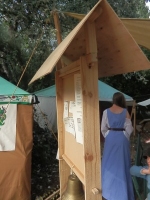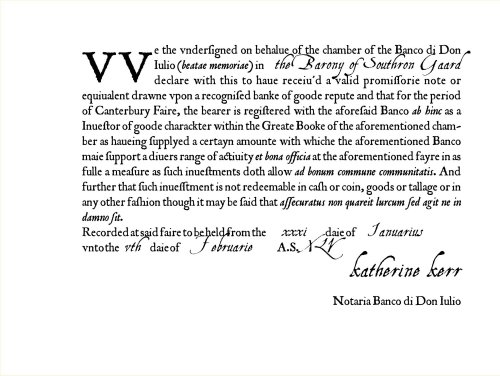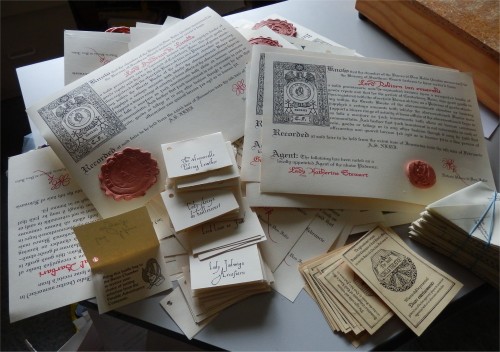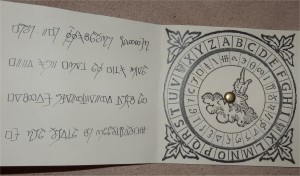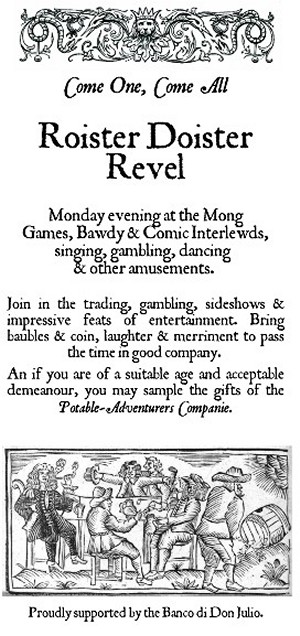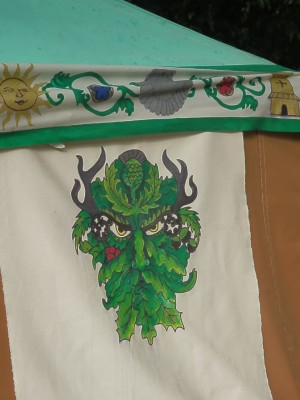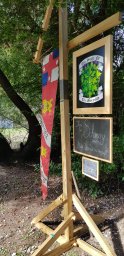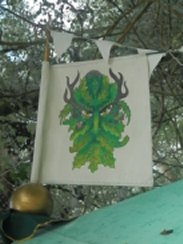 |
|
Banco di Don Julio2021 Special Offer[Banco Investment Offering] [Banco Trade Items] [Roister Doister Revel] [Half-Circle Theatre] [The Potable-Adventurers Companie] [The Green Man] [Some Historical Background] See further info on other activities and other event-related stuff. For many years, Canterbury Faire benefited from the largesse of Baron Michelet and Lord Killian, who ran the Mangy Mongol and provided potables for the populace. While the coffee is clearly a commodity to be paid for, the other potables were supported only by spasmodic donations, and came primarily from the pocket of the aforementioned gentlemen. Eventually it became too much of a burden and we had a Faire without potables and, as a result, a much quieter common gathering area as people stayed in their encampments to eat, drink and socialise.
I wanted to see if I could find a mechanism that would allow such costs to be covered without requiring any kind of actual purchase or exchange for potables taking place; the secondary aim was to bring people out of their encampments and re-establish the Mong as the place to hang out. And thus the Banco di Don Julio was born in AS45, allowing me to indulge my penchant for period research and printing practices, as well as to call in funding that could be applied to good use. I offered to cover costs and equipment expansion for what became the Potable Adventurers' Companie and also found some other useful applications of the Banco funds to spread the investment to other entertainment and infrastructure aspects of Canterbury Faire. A good time was had by all, and a handy Canterbury Faire institution was born.... I even did a period-style flowchart of the Dispersements of the Banco di Don Julio, Canterbury Faire Chamber AS45-49 (PDF) demonstrating all the activities and people involved over the initial five years. (Background research on such charts is to be found here.) And in case you are wondering why Don Julio -- well, it's a long story. You can see the song that arose from it here. A Banco is BornIn the years in which it runs, the Banco di Don Julio calls for investors of good standing to support its activities at Canterbury Faire, where the Banco has underwritten a broad range of entertainments, such as the gifts of the Potable-Adventurers Companie, a concert by noted bard Mistress Marian of Heatherdale and other such matters as it deems fit to the delight and benefit of all those attending Faire. That is, those willing to supply in advance a non-refundable investment for a designated amount gain the status of Padrone, with things like period-style share certificates, a bag of holding, Banco tokens, badges, small games and amusements, tickets for premium reserved seating at the Half-Circle Theatre with special pampering, or other such benefits as the Banco can think of. Initially, the bulk of Banco funds went to support the activities of the Potable Adventurers Companie to provide free period-style brews for an introductory Roister Revel at Faire. Any surplus funds went to a range of things such as the provision of food for the revel; sweetmeats for the Padrones and populace attending the Half-Circle Theatre; donations to the waffle-production efforts of the magnificent Breakfast Baron Kjartan; support for entertainment and children's activities, as well as aprons, shelving and lighting for the Mong/Commons area; construction of the Commons Market Cross.
In AS49, the Potable Adventurers and associated activities launched its own tent, the Green Man, complete with a Green Man painted cloth on the wall and flying from the top finial. I spent a lot of time looking at tent decoration to try to get something suitable and practical. It's quite tricky trying to get a finial and flag flying from a tent without a convenient centrepole...(Take a look at how it turned out here.) A keen supporter wanted a Padroneship despite not being able to attend Faire, and asked if he could appoint an agent. The Banco was, naturally, happy to support absentee Padrones, with any local agents attending Faire nominated to conduct such Banco business as is required (ie get the fancy seating at Half-Circle and suchlike). The absent Padrones get their certificates sent to them, along with reports on the Faire's activitites. In AS46, they all got a full set of the Canterbury Faire newsbookes, which included reports from the Banco and a listing of the Padrones. The Banco ran for five straight years, helping to revive the local Brewers' Guild, then closed but was brought back into life in 2017-18 to assist funding to bring the lovely bard Mistress Marian of Heatherdale and her accompaniest Ben Dechamps over to Faire. It has enough history now that people are pleased to see it reappear from time to time, usually when the support is needed for specific events/times. CertificationIn the first year, AS45, I included a hand-illuminated Padrone certificate, and had a Major and Minor Shareholding certificate. The former was based on the style of indulgences printed in 1497 in Antwerp (and the following year by Wynkyn de Worde at Westminster). The indulgence was issued as a measure to drum up donations for the repair of the Hospital of the Cathedral of Santiago de Compostella. It included a stamp, a seal, and a monogram from the issuing party. The monogram for the Banco documentation was based on that of Perkin Warbeck (aka Richard of England, the missing Yorkist Prince from the Tower; though some called him a Pretender), with a k on the end for me. The Minor Shareholding certificate was based on the earliest known printed share certificate still extant, as issued by the Dutch East India Company in 1606, completed with a gold Banco stamp. I had to include the commune communitatis as the text for the common good of the community (even if only for the Hot Fuzz reference). I particularly liked one of the legal phrases: assecuratus non quaerit lucrum sed agit ne in damno sit, which means “the assured does not seek profit but makes [it his profit] that he not be in loss”. That rather nicely sums up the aim of the Banco project. In following years, in the interest of frugality and reduced workload, I simply changed the dates on the older shares.
All that produced quite a lot of work, with only a small uptake of the Major Shareholding, so I simplified the preliminary offering the following year to just Padrones, with preprinted Minor Shareholdings taken in return for donations at Faire itself. Each year the Padrone's share certificates have been based on a different example of some period business-related printed matter, taking the wording and layout from a range of documents. In AS 46, the Padrone and Potable Adventurers received certificates based on another indulgence with a woodcut of angels guiding Don Julio, signed with a monogram and sealed with the Banco seal. In AS47, the Padrone certificates were based on a 1521 printed indulgence by brother Jeronimus Munghofer of the Order of St Benedict, confessor and penitencer in the Diocese of Constance, which had blanks filled in by Brother Jeronimums at St Peters Basilica recognising the penance of brothers Johan and Oswald Burg. It had a lozenge-shaped Banco seal. The Potable Adventurers received trade cards based on those of the late-1600s/early 1700s (Printed Ephemera, pg 174), with a description of the Companie location and their trade goods as well as citing the good standing of the named member. In AS48, the Padrone certificates were based on a 1513-1517 printed indulgence issued by Johannes Tietzel, who was known to sell time-limited indulgences, or even indulgences for sins not yet committed! The wording was based on one of the first banknotes ever to be issued, by the Bank of Scotland in the late 1600s, and similar to earlier promissary notes. The Potable Adventurers received a document based on some general manuscript letters.
Here's an example of the AS49 Padrone certificate wording with a designated agent, based on the Black Book of Taymouth's entry for the bond cited for Kenneth MacKenzie of Kintail (1586). The layout was based on examples of late 16th-century Scottish correspondence, as noted in the Corpus of Scottish Correspondence examples and analysis, and used Pia Frauss' lovely Wirwenzlaw font, which is surprisingly close to late-period Scottish hand for a font based on a 15th century Prague manuscript! I signed it with my official squiggle and added a Banco seal. Be it kend till all men to quhome it effeiris, Don Julio, of the Banco of that name have tane in speciall maintenance and freindschip his lovit friend Jaques de la Vetarouge, Baron of Southron Gaard, gainst all persons when the aforesaid are both within the others companie, the Crown's Maiestie the Baron of Southron Gaard and alle propir kin and frendis only excepted in reckognizance of the benevolence received by the said Don from his frend herin mentiond and his agent Lady Ursula Roberta. Suir obseruance of this mutuall band of mantenance and manrent, in maner afoir rehersit, subscryuit to at Canterbury Faire befoir witnessis, katherine kerr notary servant to the aforementioned Don Julio, duodecimo die mensis Februarius, anno societatis undequinquaginta That year the Potable Adventurers Companie had a similar document, somewhat akin to a "wanted" poster (Lord James of Southron Gaard had wistfully wished for enough notoriety that a new James could be called "not of Southon Gaard" to differentiate...). Extracts from court records in the Black Book of Taymouth provided good models for suitably stern wording and admonitions against Companie members in a document leading with Curia de Cantaurensis Mercatus Tenta Apud Meridianus Advigilo. It made an interesting change from previous years where they have received indulgences, trade cards and the like. Absentee Padrones have come from across the Known World, bless them, often from far-flung Southron Gaarders wishing some small connection with home. One generous soul gifted two Padroneships to the good people who had billeted him at a previous Faire, as a means of saying thank you. Another asked for his agency to be appointed to a worthy member of the populace (I had great delight in selecting Lady Katherine Stewart who had done such sterling work in assisting with the earthquake response, using Lochac donations to purchase useful wares and travelling for hours each day to and from our beleagured city to distribute it in the hardest-hit areas). The Game ExpandsOne of the first Padrones to invest mentioned this in his delightful letter of application: Oh, and as I have mentioned...I would like to vehemently deny that my financial backing is in any way sponsored by certain energetic Caribbean-based businessmen, themselves well versed in the kraken-risk to their own peculiar way of exercising commerce. There is also absolutely no truth to the rumour of the existence of "The Gnomes of Tortuga". Feel free to casually mention this to Ld Anton the next time you bump into him... An inquiry and some correspondence led to this notice on the Kingdom lists: It will shock few people to know that the Bank of Anton is rumoured to have taken a substantial position in the Banco di Don Julio. Monsieur de Stoc advises that if anyone wishes to take carats, or kuxen as the Germans call them, in Banco di Don Julio Holdings (Outlands) No Liability Except At Gunpoint they are to speak to him or his factors. Naturally this required a firm response, to wit: To all people of good standing, We heard no more of takeovers...However, at Canterbury Faire itself, the following notice was found tacked up in a number of areas: The Lochac Banking Inquisition, newly convened & shortly to report to the Exchequer, wishes all law-abiding Traders to know that the Banco di Don Julio has been implicated in conducting Banking Activities unregistered by the Inquisition, & has been vouching for the good character of Dubious Persons, Foreigners, dishonourable Vagabonds, landless Barons, & others Disapproved of by the said Inquisition. We figured we knew who was behind this. We pointed out that Their Majesties of Lochac were Padrones of the Banco and surely the Inquisition would not dare to aim so high....and after some negotiations we were pleased to announce in Court that the Inquisition had been taken over by the Banco for a small consideration. In AS46, the great broadsides produced by a certain Ildhafn collective ran a story titled Banco di Don Julio first to receive highest rating, noting that the Poor Standards rating agency had rated the bank as AAA, and that investigations by the Inquisition and the Banco had closed. It (accurately) noted that there had been "record subscription numbers and early demand for share offerings". I now have people asking at one Faire for a Padroneship to be reserved for them at the next. I do love it when people play with ideas and build on them. And Keeps on Growing...The play continued the following year (AS46), when the Banco once more sent out its share float notices. In one such communication, a post-scriptum read (in reference to the earthquakes that had flattened our city): Please ignore any suggestion that the lowering of the cost for this year's Padroneship is related to losses due to Acts of God -- the Pope supports this venture and we can produce the Donation documentation to prove it.... It's nice to belong to a group who can recognise a reference to the famous medieval forgery of the Donation of Constantine when they see it... One would-be Padrone responded thus: I admit I have had some concern about the stability of the Canterbury Faire Chamber of the Banco di Don Julio (and a great many other things in its general vicinity). However, remembering that last year's investment produced an acceptable return, and reassured by the support of the Pope, I wish to apply for one of remaining highly sought-after Padroneships.But I think my favourite communication was this one: I will consult with my purser and ensure that I have suitable coinage of your local mint to invest in the Banco when I attend the faire. While I'm sure my factor would be treated with the utmost respect, I prefer to oversee my investments in person. Did I mention how much joy I get out of seeing people take an idea and running with it... Banco Trade Items: a SelectionEach year I've tried to come up with new ideas for items I can include in the Padrone baggies. Some of these have been relatively simple, like a set of chestnuts to play with or a small version of the traditional Shut the Box game (sans box). Some have involved extensive research into period practice, such as the volvelle. Volvelle
I've long been fascinated by the use of volvelles in many natural history books printed during the Renaissance. These tend to be in the form of over-laid wheels and dials sewn or pinned into a work to provide quick astronomical or calendrical calculations, code-decoders, fortune telling and the like. Ramon Llull's 13thC Ars Magna has the earliest known volvelle, a three-layer one which could spin about a series of nine letters to answering all questions about Life, the Universe and everything! The first known printed one appeared in Regiomontanus' astronomy book in 1474, providing a lunar calendar calculator. By 1540, they had become complex multi-layered beasts, such as the two dozen or so appearing in Apianus' astronomical work produced for Charles V. But it was one by Giambattista Della Porta, printed in his book on steanography in 1591, which really inspired me. What if I replaced the code system he used with a simple subsitution alphabet; even better, what if I used the code symbols so badly employed by Mary Queen of Scots in the Babington Plot. Cool!
So at Canterbury Faire AS48, the Padrones received a volvelle which had been used to encode four phrases pointing the way to treasure, small jewelled crown brooches I had hidden around the site: "where the wind-rose blooms" indicated they should check out the wind-rose compass on the huge Kingdom Map hanging in the Great Hall; "seek the sign of Saint Iago" meant the treasure was hidden under a scallop shell. "Master Edward Braythwayte holds it" was a nod to the Uber Padrone as part of that year's foxy activities (more on that here). I was very impressed when the very clever Baroness Agnes di kyrri not only managed to decode all the messages (each requiring a separate turn of the wheel), but also found all the treasures. Huzzah that woman! Ye Olde Beeswax Glad Wrap For Canterbury Faire AS49, the Padrones each received a small beeswax wrap, suitable for putting over the tops of bottles to keep out dust or wasps. I don't know the specific provenance of such wraps, but they seemed to be a very practical and useful item. Mistress Rowan mentioned making them for the Abbotsford campsite, although her method seemed quite laborious involving dipping linen in molten wax and scraping excess amounts off. Ever one to take the short road, I had simply grated solid beeswax into bits (and ripped up a couple of old candles) and sprinkled it lightly over some spare calico squares. About three minutes in the oven at 100 deg C was enough to melt the sprinkles into a consistent soakage across the squares, and a trim with pinking shears finished the pieces off nicely. They proved very useful at keeping dust and insects out of bottles throughout Faire. Some larger ones were good for wrapping things like cheese and fruit. I even stamped a batch of spare ones with the Don Julio stamp (before waxing!), and used those in the Green Man. Pop-Up BancoThe Banco ran for around five years and achieved a good deal in that time in terms of providing support for a range of activities and useful items, as well as helping bootstrap the local branch of the Brewers' Guild by underwriting equipment and supporting brewing education and experience. Ironically enough, it didn't achieve my aim, which was to winkle people out of their encampments and into commons areas at Faire. By the time I couldn't even give away the donated potables, I figured it was time to call it quits. The Banco reappeared at Canterbury Faire LII (2018), when it traded once again, this time to support the appearance of the highly regarded Mistress Marian of Heatherdale, noted songster across the Known World, and her talented accompaniest Ben Deschamps. The Banco provided reserved seating at the special concert, along with a limited-edition souvenir pouch, songbook and Official Certification of the Padrone's beneficence towards the valued performing arts (useful in applications for positions in certain ducal households, we're told). As a useful structure for limited fund-raising, as well as education and entertainment, the Banco will no doubt pop up again from time to time. I'm prescient -- to help with Faire entertainment and to help cover non-budgeted items during the frugality of the plague year, the Banco rose to the challenge once more. Some Historical BackgroundWhen the idea of some sort of underwriting for various activities at CF was first mooted, my initial thought was to establish something like a Merchant Adventurers Company, but I was finding it difficult to locate examples of documentation and structure that suited my aims. I then started to look at the development of early banks and how money was collected for investment and that seemed to offer some excellent ideas for how this project could be managed in a perioid fashion. The share certificate wording for the Banco di Don Julio is based on the earliest known printed share certificate still extant, as issued by the Dutch East India Company in 1606, translated by the helpful Hannah of Hanecnolle from the Shire of Polderslot, and with a few gratuitous Latin phrases thrown in by me. I had to include the commune communitatis as in for the common good of the community (even if only for the Hot Fuzz reference). I particularly liked one of the legal phrases: assecuratus non quaerit lucrum sed agit ne in damno sit, which means the assured does not seek profit but makes [it his profit] that he not be in loss. That rather nicely sums up the aim of this Banco project. The Banco's Minor Shareholding certificate, shown above, is laid out to closely match that of the Dutch East India Company one, though our bank notary has tidier handwriting...The initial Major Shareholding certificates were based on the style of indulgences printed in 1497 in Antwerp (and the following year by Wynkyn de Worde at Westminster). The indulgence was issued as a measure to drum up donations for the repair of the Hospital of the Cathedral of Santiago de Compostella. It included a stamp, a seal, and a monogram from the issuing party. The monogram is one based on that of Perkin Warbeck (aka Richard of England, the missing Yorkist Prince from the Tower; though some called him a Pretender), with a k on the end for me. In AS46 I used the Compostella indulgence as the basis for the Padrone share certificate, with the aim of making every Padrone offering a different style. The revised certificate had a suitable woodblock on it, depicting the angels guiding Don Julio (or should that have been angles?).
According to Stock Market Trivia, the oldest printed bond related to a Holland & Westvriesland loan dated 1586. This was issued to support the war against Spain, with the investors forced to cough up (though they did get the choice whether to receive interest payments with eventual principal repayment, or receive annuity payments for life). One claim I really found intruiging was that of an early handwritten share, said to have been issued for the Stora-Kopparbergs company in 1299. The really impressive thing is that the company is still an operating concern! Stock exchanges themselves became operational in late-ish period, with the Anstwerp Bourse opening in 1460, followed by Lyons (1506), Toulouse (1549), Hamburg (1558) and the London Royal Exchange (1571). Despite the strong presence of the French and Low Countries in stock market development, the whole banking industry as we see it today really kicked off in the Italian city-states of the 14th century (though Gilbart dates the Venetian bank to as far back as 1157). Florence, Venice and Genoa were the main proponents, with the likes of the Medicis, the Peruzzis and other trading families establishing systems to provide loans, international money transfers, securities and -- dare one say it -- income from interest. The Chamber of St George -- a Genoan bank established in 1407 -- was even given several cities and territories (including Caffa and Corsica) as security for handling state debts. The Italian term banco is said to refer to the green cloth-covered benches used in the marketplace to exchange money and bills. According to Gilbart's history of banking, when a banker failed, his bench was "broken by the populace" (whence the term bankrupt). The Venetians are said to have promoted the idea of joint stock funds as a means of financing various conflicts through a forced loan from its citizens. Gilbart says that: The citizens received Stock certificates in exchange for the sums they paid, bearing interest, which they might sell or transfer to any one else. The original loan was called the Monte Vecchio: afterwards two other similar Loans were contracted which were called the Monte Nuovo and Monte Nuovissimo. In the 1400s, Montes Pietatis were developed, partially as a reaction to money-lending. These Banks of Charity were based on "a collection of funds from voluntary donations by financially privileged people who had no intentions of regaining their money" -- so could really be said to be the true model for the Banco di Don Julio. England had a version of these, with the first one founded in 1361 as a pawnbroker which lent money but didn't charge interest. They had a fairly modern-sounding structure, with a director (a depositarius), an appraiser, an accountant (notarius) and even sales staff. The Padrone and Major Shareholdings were initially limited to sixteen. As well as ensuring we don't have an embarrassment of riches, this also conforms to period practice (though the decision to drop the price in the following year meant an expansion in Padroneships). According to the Oxford University Press Shakespeare's England, published in 1917: Shareholding is in itself one of the most primititve devices of mankind and there appears to be some mystical reason for a division by sixteenths. Sixteen Celtic households within a tribe shared the use of the land; sixteen German miners in the thirteenth century formed a working fellowship...the shares in the Blackfriars Theatre which raised Shakespeare to affluence, were likewise sixteenths. Being British-based, the work goes on to claim that "the typically moden form of shareholding, by which the capital of the outside public is made to fertlise enterprises which are beyond the resources of the individuals, may almost be said to have had its beginnings in Shakespeare's time". I did briefly toy with using the Italian Monte term instead of Banco. Given the complete transparency of the offering, I could then have called this project the Full Monte.... Perhaps that would have reassured those who were worried that this piece of financially inspired performance art might be taken too seriously. Roister Doister Revel: Monday evening, Canterbury Faire
Come join the rabble for dubious games, bawdy and/or comic presentations, folk and filk songs, peasant dances and other amusements to pass the time at the Roister Doister Revel. There may be trading, gambling, sideshows and impressive feats -- there will be laughter and merriment to pass the time in good company. The Potable-Adventurers Companie will be gifting their production, to be made available to those of a suitable age and demeanour. In AS45, the new Roister Revel at the beginning of Faire gave us a chance to highlight the Mong area. Lord Bjorn and I spent most of the evening serving the output of the Potable Adventurers Companie at the Revel and had plenty left over for supply through the rest of Faire; a situation which has carried on in the years since. At the first revel, the coconut shy proved oddly compelling for some; an early children's activity was to decorate the coconuts with faces and finery, ready for the evening's frivolities. Mistress Crispin and Master Katherina (in suitable cross-dressing attire) presented a delightfully over-the-top ballad about certain of my exploits. It felt like a good way to start off the event. The following year we began on the Sunday evening with a pouring of potables so that people could raise a glass and toast the health of the newly invested Baron and Baroness of Southron Gaard. The Roister Revel saw more dubious entertainments, and I'm hoping in future that these will grow into a full-scale games and gambling evening as people get the idea (and we invest in more lighting for the area). It may provide a useful place for a Peasant's Dance, allowing a venue for the less-period of the simple dances that people like; a stage for filky, folky bardic offerings I'd like to keep away from the Half-Circle Theatre; a time for frivolous sideshows and gypsy shenanigans. We'll see what develops. Half-Circle TheatreThe right noble and virtuous Dramatikal Compagnie of Lord Lovel's Men doth array upon the stage The Half CIRCLE THEATRE, wherein shall be presented divers entertainments gathered out of the best approved players and musicians augmented with ne'er before seen interludes. To be held in the Half-Circle on Wednesday evening; if the weather prove inclement, we shall repair to the Great Hall. Reserved seating with half-time pampering will be provided to Padrones of the Banco di Don Julio. Groundlings are welcome to bring cushions and other such comforts of their own. Half-Circle is a tradition at Canterbury Faire. We now decorate the newly extended amphitheatre seating with fancy organza drops donated by Mistress Taddea, so the Padrone seating looks suitably splendiferous. Little "Reserved for Padrone" cards helps keep the hoi-polloi to the groundling area. It looks like it'll be the availability of seating at Half-Circle that is likely to be the limiting factor on Padrone number, as we can seat up to around 30 or so. All Padrones are treated to roasted nuts and/or other treats held in a folded packet made out of misprints from various of my period printing projects. In AS48, the theatre for that year was rebranded the Braythwayte Master Theatre; here's why. The Potable-Adventurers CompanieThe Potable-Adventurers Companie consists of a fine group of upstanding gentles who are exploring the realms of potable production, discovering the arts and sciences involved in bringing such to fruition, and who have the generosity of spirit to donate said production to the benefit of all of suitable age and demeanour at the Roister Doister Revel held at Canterbury Faire. Inaugural members of the Potable Adventurers Companie: The Banco was established with the aim of providing funding for those Companie members who needed equipment, and to cover any production expenses so that no-one was out of pocket. The more intangible result was that people got more experience and learned more about their particular area of brewage. The Adventurers must have enjoyed it first time round, as a couple asked me after Faire whether the Banco was going to operate again, and said they had new ideas for brewing; others have since asked to join in. Wine and lager, mead and cider are all popular, but most popular of all in the second year was the non-alcoholic ginger beer and short mead, which was good to see. The first year, we ended up with around 250 litres gifted to the event, ranging from non-alcoholic Short Mead to Elderberry Wine, Cider from the Highlands to a limited amount of Lindisfarne Bonfire Beer courtesy of an Ordo Cygni brewer. I made up special labels for all the different brews and a summary sheet for the punters. We didn't use most of the labels as it was easier to simply stand the bottles on their individual descriptive sheets than label them individually, so that's been the practice since. The Adventurers were given a certificate of membership to show them as people of Good Standing, and that tradition has continued. In the second year, we had about the same volume, but involving 15 different brews as Companie members experimented (and grew along with the resurgence of the Brewers' Guild). I'm now attempting to limit the amount of any one brew, to cut down the volume, but keep the non-alcoholic offerings at a significant proportion, specially the lovely Sparkling Elderflower made by Mistress Rohesia. We were careful to stress that the potables had been gifted to all attending the event; it was not necessary to have any holding in the Banco to benefit, so there was no question of us selling the brews, but just giving them away. Having an active Asset Manager and the output stacked in a separate tent meant we could control supply in terms of checking appropriate age and physical status so as to act as responsible hosts (in any event, neither has presented any problem). I had the occasional volunteer help out with pourage and they were given a special Banco badge in thanks, as were any event heralds who announced Banco news during the day's rounds. It was very sweet to see how much this small touch pleased those involved. Two members of the Potable Companie wanted to supplement their brewed offerings and so, in AS46, we had two types of handmade sausages (smoked andouille and jagerwurst) and beef jerky, courtesy of Lord Thorald and Lord Timothy respectively. The good Ladies Bethany Hayward and Isabel Winter were kind enough to run classes on bread-making and cheese-making first thing on Monday, with the results turning up at the Roister Revel, so a yummy time was had by all, with all materials funded by the Banco. Since then we've had a variety of offerings to accompany the potables and help make it a special evening. In the initial offering, one Padrone told me afterwards that he'd had no idea that the Banco was funding the Potable Adventurers' Companie -- had he realised that, he said, he would have bought two Padroneships. I was delighted, as the idea was to keep the two organisations at arms' length, but also to give a more period means of playing and gain a greater understanding, whether about period brewing or banking. This seems to be a pretty good way to meet the letter of the law, provide a safe environment and give people a means to learn. The Green ManI have to confess to suffering from bad tent envy for many many years. I don't camp enough to justify getting a period tent, but I'd dearly love one. I've had various stop-gap measures over the years, ranging from an umbrella-based "pavilion" to organising a series of sunshades (one of which became the Half-Circle Theatre). For a number of years, the Banco di Don Julio borrowed a spare Mong tent, but I eventually had a rush of blood to the head and bought Lord Bjorn's old green and brown canvas one. Then followed repairs, a lot of repairs. We used some iron-on canvas recommended by professional tent folk, and had a lovely canvas repair chap take to it, turning a long rip in the middle of one wall into a useful additional door. An over-long pole in another side provided just enough head space to be able to walk in without ducking. Lots of reading gave me various ideas about decorating the tent, and thus the Green Man was born in time for AS49. It proved a good size for holding a large amount of potables and associated materials, and the green theme was carried with a batch of green covers for half-a-dozen hay bales in an attempt to encourage people to sit down and be sociable. If you want to see the research on tent decoration, take a look at my class handout: Pavilion Decoration: some quick, easy ways to bling up your canvas tent or gazebo popup.
I spent most of one week-long break over winter painting up a valence to run along one side of the tent. This was a simple rectangular decoration based on period examples. Mine centred on the tower of Southron Gaard, with a range of charges stretching away on either side -- a pelican, a knight's belt, a laurel, a lymphad, the Caidan cross, the Canterbury Cross, a pilgrim's scallop shell, a Yorkist sun in splendour and heraldic rose, and a fleur-de-lys, alternately in gold and silver. The acanthus leaf scrollwork had as centrepieces the populace badge of Lochac on either side of the central tower, then quatrefoils in blue and red thereafter. The whole thing stretches almost four metres long and is around 200 cm high. A set of grommets match the pole points to keep it nice and taut, and it looked great when it went up. The painting of the Green Man himself is a composite of lots of different artwork, mostly inspired by a lovely Canterbury Faire T-shirt design by the very talented Lord Ronan. Included among the leaves are oak and ivy, ferns and thistles, rowan berries and acorns, as well as a bushy set of punga/springing fern eyebrows, a New Zealand touch of which I am particularly proud. Then I was very lucky to be given a sign made by Ronan and his equally talented father, with a beautifully painted Green Man (on both sides), and the solidest timber frame you could ever imagine. It makes a great addition to the site, and bears a blackboard to update activities in the area.
The main item I struggled over was the finial to sit on top of the tent -- it looked like every respectable tent from the 14th century on had one of those. Mine was a bit of a hodge-podge: a polystyrene ball and collar, some old gazebo material, a recycled gazebo pole and some gold spray paint. It almost worked -- I ended up with nice shiny gold ball and green cloth base, with a painted flag flying from it, but fixing the actual finial in place proved to be the difficult thing. It didn't help that the tent had a set of sprung poles for roof support -- great for providing lots of open space, but not so handy in providing a secure centrepole position to drop a finial pole over. More research -- and a lot more tinkering -- is required. I confess this photo cheats -- tilt your head way to the left to get the actual profile. Course it didn't help that a branch hit it as the tent went up! I ended up giving a class on tent decoration at a baronial A&S session. Here's the associated handout on Pavilion Decoration: some quick, easy ways to bling up your canvas tent or gazebo popup.
| ||||||||||||||||||||||||||||||||||||||||||||||||||||||||||||||||||

